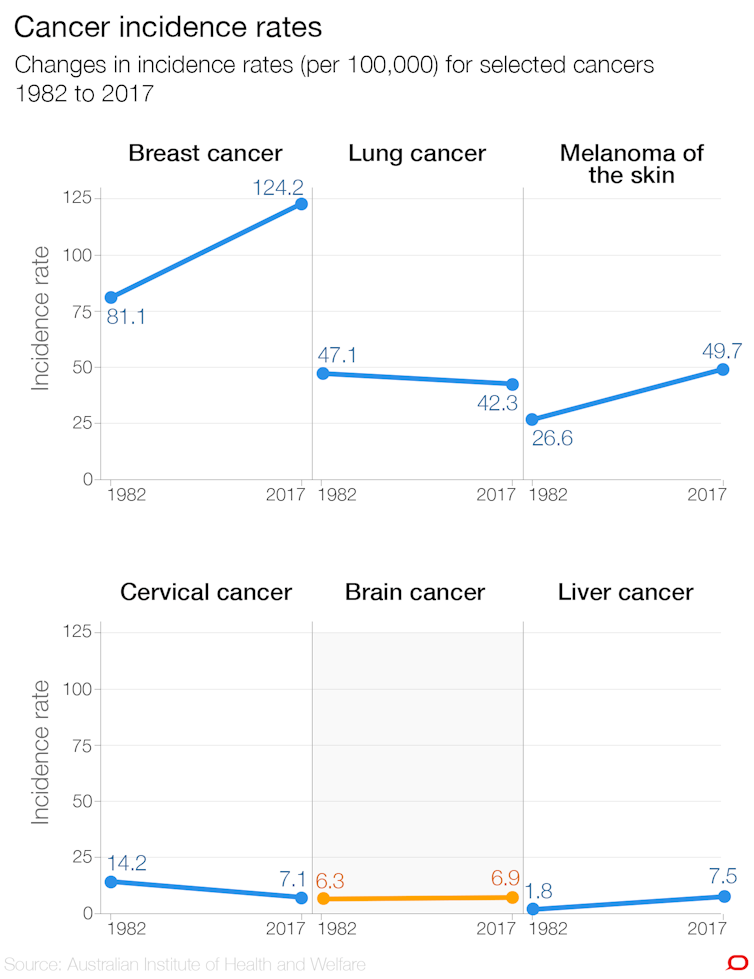Three charts on: brain cancer in Australia
- Written by Melinda Tea, Research Associate, Centre for Cancer Biology, University of South Australia
 All brain tumours are associated with significant sickness and death, even if they are benign.from shutterstock.com
All brain tumours are associated with significant sickness and death, even if they are benign.from shutterstock.comWhile survival rates for most cancers continue to improve in Australia, brain cancers aren’t seeing the same success. Australians diagnosed with brain cancer had around a 25% chance of surviving for five years from 2009 to 2013. This was compared to a survival rate of 68% for all cancers combined in the same period.
Brain and central nervous system cancers (CNS) can be either malignant or benign, but unlike benign tumours in other tissues, all brain and CNS tumours are associated with significant sickness and death.
Survival rates
It is estimated that 2,076 new cases of brain and other CNS cancers will be diagnosed in Australia in 2017. Around 1,500 people will die from this disease.
While the survival rate is 25% for brain cancer in general, for certain brain cancers it’s much worse. For instance, glioblastoma, the most common form of brain cancer in adults, has a five year survival rate of 4.6%.
So why hasn’t there been an improvement in survival in the last 30 years for patients with brain tumours? A frequent problem is that it’s hard for drugs to actually get to the tumour. The brain has a unique defence, termed the “blood-brain barrier”, that limits the passage of drugs from the bloodstream into the brain.
Read more: What is the blood-brain barrier and how can we overcome it?
Indeed, most chemotherapies are stopped from getting to the brain by the blood-brain barrier. Those that do, such as temozolomide used to treat brain tumours including glioblastoma, unfortunately have limited efficacy, and only improve survival by several months at best. There is clearly a desperate need to identify new drug targets and more effective therapies for brain tumour treatment.
Incidence rates
Incidence rates for brain and CNS cancers have stayed steady for some decades but the sickness and death that comes with the disease continues to affect many Australian lives. A recent report from the Australian Institute of Health and Welfare shows that the incidence of many cancers has increased over time.
 CC BY-ND
CC BY-NDIn many cases this is due to our ageing population, as cancer is more common in older age. But other lifestyle factors also play a role. For example obesity, type two diabetes and alcohol consumption are three major risk factors for liver cancer, rates of which have increased.
Read more: Three charts on cancer rates in Australia, where liver cancer is on the rise while other types fall
The incidence of some other cancers has decreased though. In the case of lung cancer, this is likely due to a decrease in smoking. While the introduction of a vaccine for the human papillomavirus (HPV) (which is responsible for most cases of cervical cancer) would explain the drop in cervical cancer rates.
In comparison, the overall incidence of brain cancer has remained stable over the last 30 years, probably because there are no known lifestyle or environmental factors that contribute to these cancers. While we don’t know what causes brain and CNS tumours, there is evidence to suggest genetics and high levels of radiation may play a role.
Childhood brain cancer
While many cancers almost exclusively present in older people, this is not the case with brain tumours, as these kill more people under 40 than any other cancer.
Perhaps of most concern is that brain tumours disproportionately affect children, killing more children (aged 1-14 years old) in Australia than any other disease. They are only third to land transport accidents and congenital and associated abnormalities as causes of child death in Australia.
The prognosis for children with brain cancers, the most common being medulloblastoma, is much better than in adults though. Around 70% of these patients will have curable disease.
But, undergoing life-saving treatment such as surgery, chemotherapy and radiation comes at a long-term cost for these children, as these therapies themselves are associated with detrimental effects on childhood development. These can potentially result in neurological defects, learning difficulties, growth abnormalities and mental health issues.
Read more: We made great strides with childhood leukaemia – we can do the same for brain cancer
The Australian government recently announced a A$100 million dollar medical research fund committed to doubling the survival rates and improving the quality of life of patients with brain cancer over the next ten years. It is hoped with this substantial investment, progress will be made to eventually defeat brain cancer.
Stuart Pitson receives funding from the National Health and Medical Research Council of Australia, the Neurosurgical Research Foundation and the Fay Fuller Foundation
Melinda Tea does not work for, consult, own shares in or receive funding from any company or organisation that would benefit from this article, and has disclosed no relevant affiliations beyond their academic appointment.
Authors: Melinda Tea, Research Associate, Centre for Cancer Biology, University of South Australia
Read more http://theconversation.com/three-charts-on-brain-cancer-in-australia-86610





